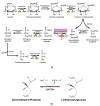Oxidatively modified glyceraldehyde-3-phosphate dehydrogenase (GAPDH) and Alzheimer's disease: many pathways to neurodegeneration
- PMID: 20164570
- PMCID: PMC2922983
- DOI: 10.3233/JAD-2010-1375
Oxidatively modified glyceraldehyde-3-phosphate dehydrogenase (GAPDH) and Alzheimer's disease: many pathways to neurodegeneration
Abstract
Recently, the oxidoreductase, glyceraldehyde-3-phosphate dehydrogenase (GAPDH), has become a subject of interest as more and more studies reveal a surfeit of diverse GAPDH functions, extending beyond traditional aerobic metabolism of glucose. As a result of multiple isoforms and cellular locales, GAPDH is able to come in contact with a variety of small molecules, proteins, membranes, etc., that play important roles in normal and pathologic cell function. Specifically, GAPDH has been shown to interact with neurodegenerative disease-associated proteins, including the amyloid-beta protein precursor (AbetaPP). Studies from our laboratory have shown significant inhibition of GAPDH dehydrogenase activity in Alzheimer's disease (AD) brain due to oxidative modification. Although oxidative stress and damage is a common phenomenon in the AD brain, it would seem that inhibition of glycolytic enzyme activity is merely one avenue in which AD pathology affects neuronal cell development and survival, as oxidative modification can also impart a toxic gain-of-function to many proteins, including GAPDH. In this review, we examine the many functions of GAPDH with respect to AD brain; in particular, the apparent role(s) of GAPDH in AD-related apoptotic cell death is emphasized.
Figures







Similar articles
-
Oxidatively modified glyceraldehyde-3-phosphate dehydrogenase in neurodegenerative processes and the role of low molecular weight compounds in counteracting its aggregation and nuclear translocation.Ageing Res Rev. 2018 Dec;48:21-31. doi: 10.1016/j.arr.2018.09.003. Epub 2018 Sep 22. Ageing Res Rev. 2018. PMID: 30254002 Review.
-
Glyceraldehyde-3-phosphate dehydrogenase is involved in the pathogenesis of Alzheimer's disease.Arch Biochem Biophys. 2024 Aug;758:110065. doi: 10.1016/j.abb.2024.110065. Epub 2024 Jun 19. Arch Biochem Biophys. 2024. PMID: 38906311 Review.
-
Glyceraldehyde-3-phosphate dehydrogenase (GAPDH) and Alzheimer's disease.Pathol Biol (Paris). 2014 Dec;62(6):333-6. doi: 10.1016/j.patbio.2014.08.002. Epub 2014 Sep 22. Pathol Biol (Paris). 2014. PMID: 25246025 Review.
-
The amyloid precursor protein affects glyceraldehyde 3-phosphate dehydrogenase levels, organelle localisation and thermal stability.Mol Biol Rep. 2020 Apr;47(4):3019-3024. doi: 10.1007/s11033-020-05364-z. Epub 2020 Mar 9. Mol Biol Rep. 2020. PMID: 32152789
-
Exploring the Role of Glycolytic Enzymes PFKFB3 and GAPDH in the Modulation of Aβ and Neurodegeneration and Their Potential of Therapeutic Targets in Alzheimer's Disease.Appl Biochem Biotechnol. 2023 Jul;195(7):4673-4688. doi: 10.1007/s12010-023-04340-0. Epub 2023 Jan 24. Appl Biochem Biotechnol. 2023. PMID: 36692648 Review.
Cited by
-
Oxidative stress in HPV-driven viral carcinogenesis: redox proteomics analysis of HPV-16 dysplastic and neoplastic tissues.PLoS One. 2012;7(3):e34366. doi: 10.1371/journal.pone.0034366. Epub 2012 Mar 28. PLoS One. 2012. PMID: 22470562 Free PMC article.
-
A genome-wide detection of copy number variations using SNP genotyping arrays in swine.BMC Genomics. 2012 Jun 22;13:273. doi: 10.1186/1471-2164-13-273. BMC Genomics. 2012. PMID: 22726314 Free PMC article.
-
Genetic variants in GAPDH confer susceptibility to sporadic Parkinson's disease in a Chinese Han population.PLoS One. 2015 Aug 10;10(8):e0135425. doi: 10.1371/journal.pone.0135425. eCollection 2015. PLoS One. 2015. PMID: 26258539 Free PMC article.
-
Defining the Role of Isoeugenol from Ocimum tenuiflorum against Diabetes Mellitus-Linked Alzheimer's Disease through Network Pharmacology and Computational Methods.Molecules. 2022 Apr 7;27(8):2398. doi: 10.3390/molecules27082398. Molecules. 2022. PMID: 35458596 Free PMC article.
-
Monitoring GAPDH activity and inhibition with cysteine-reactive chemical probes.RSC Chem Biol. 2022 Jun 9;3(7):972-982. doi: 10.1039/d2cb00091a. eCollection 2022 Jul 6. RSC Chem Biol. 2022. PMID: 35866162 Free PMC article.
References
-
- Sirover MA. New insights into an old protein: the functional diversity of mammalian glyceraldehyde-3-phosphate dehydrogenase. Biochim Biophys Acta. 1999;1432:159–184. - PubMed
-
- Jenkins JL, Tanner JJ. High-resolution structure of human D-glyceraldehyde-3-phosphate dehydrogenase. Acta Crystallogr D Biol Crystallogr. 2006;62:290–301. - PubMed
-
- Branlant G, Branlant C. Nucleotide sequence of the Escherichia coli gap gene. Different evolutionary behavior of the NAD+-binding domain and of the catalytic domain of D-glyceraldehyde-3-phosphate dehydrogenase. Eur J Biochem. 1985;150:61–66. - PubMed
-
- Sirover MA. Role of the glycolytic protein, glyceraldehyde-3-phosphate dehydrogenase, in normal cell function and in cell pathology. J Cell Biochem. 1997;66:133–140. - PubMed
-
- Baxi MD, Vishwanatha JK. Uracil DNA-glycosylase/glyceraldehyde-3-phosphate dehydrogenase is an Ap4A binding protein. Biochemistry. 1995;34:9700–9707. - PubMed
Publication types
MeSH terms
Substances
Grants and funding
LinkOut - more resources
Full Text Sources
Other Literature Sources
Medical
Molecular Biology Databases
Research Materials

